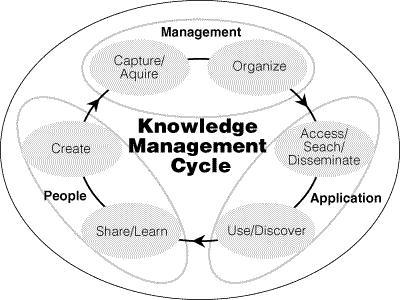KM cycle

When implementing the tools provided by KM in a company, different steps are followed to achieve a successful result.
These steps are accommodated in a cycle and the company must repeat them to achieve constant invigoration and improvement
Gauvin and Waruszynski (2003) and Rahul (2012) support the model that states six steps for the knowledge management cycle, this are discussed as follows:
- Share and Learn: The sharing of knowledge in order to facilitate learning is the first step in knowledge management life-cycle. Sharing of knowledge is one in which people exchange their views and ideas on a particular domain.
- Create: Knowledge is created by sharing of ideas by people working in an organization (Patriotta, 2004, p. 10). Better sharing leads to better ideas thereby creating a valuable knowledge repository.
- Capture and Acquire: Capture and acquisition of knowledge is one in which the knowledge created is collected in huge numbers and stored in a repository.
- Organize: Organizing is the next step to capturing of knowledge. The captured content is organized using a framework or knowledge model. The model reflects the elements of knowledge and flows that are embedded inherently in the specific processes and culture of organization.
- Access, Search and Disseminate: The organized knowledge is put in such a way that it could be accessed, searched and disseminated by the users working in the organization.
- Use and Discover: The last step is to make use of the knowledge acquired in solving problems in real time.

Knowledge Management Cycle, Source: McIntyre, Gauvin and Waruszynski, (2003).
Different models of KM cycle have emerged but between the constant steps are the acquisition of information, storage, capture, feedback loops, distribution and sharing learning
Bibliography and references:
Rahul, Rajalakshmion (2012). Knowledge management cycle.
